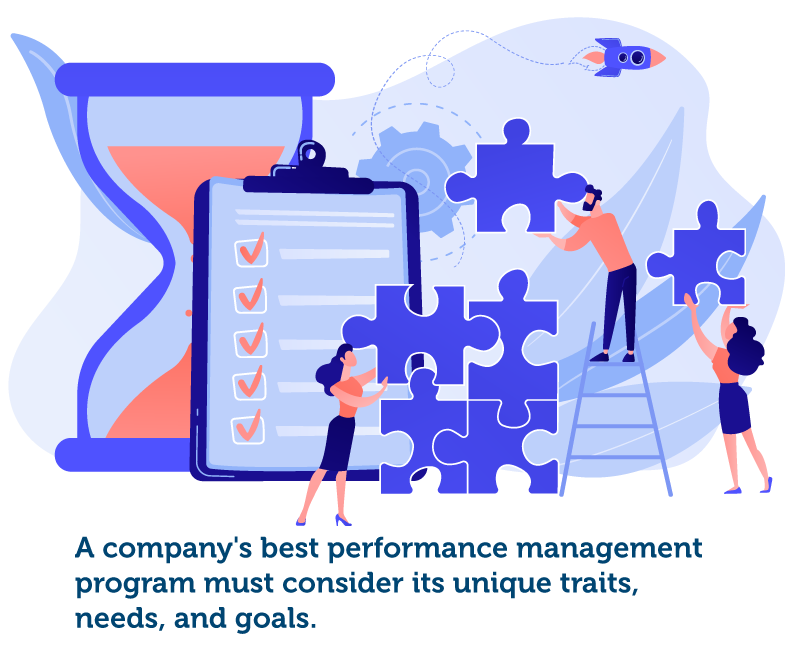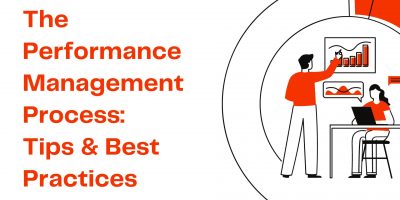
Strategies for Boosting Performance & Managing Stress in the Workplace
Learn practical techniques for enhancing productivity and effectively managing stress in the dynamic workplace environment, ensuring a balanced and thriving workforce.

In 2002, Global HR Director of Colorcon, Brian Jensen, astounded his audience, revealing that his company steered away from the traditional annual reviews and found a new effective way of managing performance and enhancing preferred behavior.
This sparked curiosity among HR executives about what performance management is in this new form and how it can help their organizations.
Performance management is a corporate tool that enables managers to monitor and evaluate employees’ work. It fosters meaningful communication between supervisors and their teams throughout the whole year.
Through constant interaction, it aims to align the company’s workforce, skills, resources, and systems toward achieving the strategic goals. It helps identify any weaknesses in a company and find ways to improve the critical areas.
The big companies, such as Adobe, Deloitte, and General Electric, were the first to recognize performance management‘s new shape that can have enormous potential in helping companies grow.
Therefore, it is no surprise that today performance management statistics show that 81% of HR leaders are making changes to performance management.

Effective performance management can be the turning point in a company’s success. In fact, according to research, organizations with solid performance management perform 92 times better and typically outperform their competitors by 24%.
Therefore, it is evident that strong performance management can benefit employers and their employees.
Frequent reviews are an excellent tool for identifying employees’ skillsets. When workers discuss their roles and responsibilities regularly, managers can determine any gaps in lack of skills and address them before they impact productivity.
Constantly following employees’ performance can improve employee recognition and give a clear picture of who is eligible to get a promotion and take on a new role in the company. Promoting internally in an organization saves on recruiting costs. In contrast, standard checks also identify and document under-performers and help smooth the process of terminating those employees.
After determining the talent at the company, it is crucial to retain it. Effective performance management allows employees to have fluid and transparent conversations about their needs and expectations with their managers. This enables leaders to resolve any issues and concerns quickly and effectively. In fact, according to research, companies that implement continuous feedback have 14.9% lower turnover rates.
Stacking up a year’s worth of feedback doesn’t help employees realize their weaknesses and give them time to handle them. However, workers who receive continuous feedback throughout the year are always aware of gaps and can quickly and effectively tackle them without harming their morale and productivity.
Workers who are made aware of their performance – where they stand at the moment or what they need to do to improve – feel more engaged in their work. For 78% of employees, acknowledging their hard work motivates them to be more productive in their jobs.
Performance management determines the company’s goals and the worker’s roles in achieving them. Being aware of this, employees are relatively free to decide how to handle their responsibilities. In this context, every worker has the chance to design their activities, making them accountable for their work.
High-performance management includes executing HR practices that are consistent and aligned with a company’s strategy and objectives. The most important aspect of high-performance management is that it is an ongoing process that implements different activities to create an effective performance management cycle.
As easy as it may sound, developing a high-performance management process is hard work that requires lots of attention and effort. Many practices can be included in the process, but some essential ones help ensure it performs the way it should.
Setting goals increases employee engagement as it makes employees a part of the decision-making processes. In turn, this boosts productivity as they have the opportunity to define a goal they will be working towards achieving.
In today’s constantly changing workplaces and roles, regularly realigning goals and KPIs following a role’s workload saves costs and supports cross-functional processes. It’s crucial to align employee and organizational goals so that employees know how their work will contribute to the company’s success.
Setting goals might be the most essential practice for any company as it gives managers and employees a clear idea of their responsibilities. Poorly defined goals can result in bad performance and create uncertainty in the company’s future.
Therefore, goals should be SMART: specific, measurable, actionable, relevant, and time-bound. But it is also important to break them down into steps and constantly follow their ongoing development.
“Objective and key results” (OKRs) enable management to communicate and track the ongoing process of the defined goals. Collaboration is vital when agreeing upon OKRs and having a platform to follow and revise objectives and receive live feedback is a great tool to maximize their outcomes.
Regular and continuous feedback gives more insight into employee performance and helps workers understand what is expected of them. The best thing about it is that it keeps everyone on the same page.
However, it is crucial that feedback is not a one-way street but is presented through a 360-degree lens. It means that managers not only give feedback to their workers but also receive feedback so they can become mindful of any employees’ issues or concerns.

1. Google
Unsurprisingly, Google is an example company that implemented a novel performance management workplace system. From the beginning, it steered away from traditional management and adopted a new technology-based approach.
Setting goals using OKRs is something Google has been doing for a long time and is constantly refining this approach to help employees create and achieve their goals by themselves.
Additionally, assessing their employees’ performance and creating training and development opportunities based on data and analysis is an excellent way to set them up for success.
2. Facebook
Facebook is another example of how innovative performance management can help achieve tremendous results. Their process puts massive emphasis on peer-to-peer feedback. In addition, they also have internal software to provide live, real-time feedback.
This way, they can see how well their teams are performing, where collaboration thrives, or where it is lacking.
3. Accenture
Accenture eliminated 90% of its previous process, eliminating annual reviews and developing a more fluid system where employees get timely and ongoing feedback from their managers.
Additionally, they created an internal app for communicating feedback between all employees and focused on immediate employee development based on regular assessment.
Once it’s understood what performance management is, another important thing to consider implementing is a performance management system.
A performance management system tracks employee performance consistently and measurably. It relies on a mix of technologies and methodologies to ensure that all employees work towards achieving the company’s strategic objectives.
An adequate system can provide a lot of value for an organization. The right tools can help leaders close employee skills gaps, increase revenue, and improve the employee experience.
A performance management system can have many different tools and features, but to maximize employee performance and boost a business’s success, some are more important than others.
Goals are the key to a company’s success. Systems enable everyone in the organization to set and track goals with transparency and alignment to objectives.
A well-designed system empowers managers to have regular and effective performance reviews. It helps keep the conversations transparent and two-way.
With the development of technology, a system can determine the skills gap in an organization and suggest practical training sessions.
Leaders must know who is doing the best work, is eligible for promotion, or is underperforming at work. A performance management system can provide all this information so managers can make talent decisions based on credible data.
A performance management software has many incredible benefits, leading back to clear communication and precise expectations. Performance management software is helpful for short-term strategies and long-term business objectives.
With many software options available, choosing the best one can be overwhelming. Here are some successful and effective software choices to help any business achieve its objectives.
Synergita is a quick and easy solution for performance management, employee engagement, and OKRs. It enables managers to become aware of goals, KPIs, and achievements.
Moreover, it empowers employees with development-focused feedback and coaching opportunities. Additionally, it helps HR teams by digitalizing the processes, thus allowing them to focus on strategic employee engagement and development activities.
2. Workday
Workday helps companies understand, align, and develop their workforce. It gives detailed insight into employees’ performance, skills, abilities, and career interests to help them realize their full potential and drive organizational growth.
It lets managers understand talent strengths and weaknesses and suggest actions through reporting and analysis. It encourages collaboration via frequent check-ins and real-time feedback.
3. ADP
ADP has an easy-to-use interface and intuitive design which helps employees, managers, and HR professionals with their activities. It keeps them engaged throughout the year, thus keeping the company on track.
Additionally, it boosts the effectiveness of performance plans with the right tools, such as prioritizing and aligning goals, peer feedback, and tight integration. The reporting and analytics infrastructure is at the heart of the software, offering superb visibility and empowering employees at every level.
4. Lattice
Lattice is a holistic performance management platform with great tools to help growing companies. It lets businesses run different feedback cycles highlighting updates, peer feedback, and goals.
It encourages managers to set up one-on-one meetings and makes them more effective and productive by providing collaborative agendas and action items. It allows employees to receive public recognition and praise to boost employee engagement.
5. Ceridian
Ceridian allows an organization to define different objectives, such as individual, team, or organizational ones, and link them together in the system. In addition, it lets leaders assign competencies to employees and measure and assess their progress.
It measures performance with a holistic and continuous view, helping businesses gain a deeper understanding of their employees through reviews completed by their managers and peers.
With one-third of US companies abandoning the traditional reviewing process, numerous companies are turning to performance management software to ease and elevate the process.
Gravy Analytics turned to software to help them with performance management, employee satisfaction, and reporting. Using the software’s features, they improved in many areas.
The regular reviews made way for more employee development opportunities. Multiple channels to give anonymous feedback made it more relevant and helped management understand employee satisfaction better.
Barnes Denning, one of the 200 largest accounting firms in the US, decided to implement performance management software in 2017 after realizing its employees hated the process of getting feedback.
With the software’s help, they managed to save weeks of time off the review process, increase the frequency of getting employee feedback, oversee performance in real-time, facilitate performance conversations, and, most importantly, have a positive performance management experience.
3. US Army
The US Army required software to help its leader manage performance aligning with its strategy. They chose a provider to develop the Army Strategic Management System (SMS) to deliver strategic assessment capability.
With the implementation of SMS, all commands use the same performance management software, making it more economically sound and productive. The software provides many benefits such as helpdesk, training, configuration management, and many more.
Application performance management (APM), also called application performance monitoring, is the practice of monitoring and tracking key software performance metrics of a business’s critical applications.
It helps organizations make sure that the applications meet their expectations. If that is not the case, it alerts administrators about the issues or automatically resolves them before they impact the business.
To ensure meeting the designated company’s goals, APM should follow a set of best practices.
One must first understand the business processes and prioritize the monitoring requirements to choose the right tool. Identifying the company’s most critical transactions for its objectives is also crucial.
Set up alerts to stay up-to-date with any issues, but ensure they are configured intelligently. Receiving too many alerts can become overwhelming for the IT department, and it will reduce their effectiveness.
Prioritize alert messages and decide on the critical issues that need to be addressed immediately.
Applications often fail. Therefore, it is recommended to be proactive and regularly test and verify the alerting protocols. Since businesses are constantly evolving, it is best to build an APM that is easy to maintain whenever changes are necessary.
It is crucial for a company that uses applications to implement an application performance management process to ensure that they deliver the best experience for employees or customers, depending on the business. In many cases, monitoring is the key to improving performance.
i-nexus is a software company that wanted to change how they developed and deployed their software by moving to a more agile approach. With the implementation of an application monitoring solution, they managed to speed up the release cycles, the resolution, and onboarding processes and eliminate any blind spots in their applications.
2. Digicel
Operating in 31 countries, Digicel is a leading mobile network provider that needed help performing health checks and analyzing performance issues. After turning to application management software, they increased their application health checkups by 40%, reduced their downtime by 60%, and increased their adherence to SLAs by 20%.
3. Karavel
Karavel, France’s number one travel site, faced many problems, such as site performance issues, framework bugs, and resource leakages. With the help of application management, they reduced their MMTR from hours to minutes, increased the performance of important business transactions by 20%, and improved alignment across all teams in the organization.

Every company is different. Therefore, having a “one-size-fits-all” performance management program that will ensure positive outcomes for every organization is impossible.
There are various performance management programs that businesses can implement. In deciding what performance management program is best, a company must consider its unique traits, needs, and goals.
This program is quite logical and straightforward. But, for it to work, everyone in the company must commit to their role in the process. It includes three key steps:
Feedback from employees on how performance management should look gives relevant insight and increases workforce engagement and awareness of the processes.
Dedicated software can produce incredible results in performance management by analyzing data. What is crucial when basing performance management on software is that the software is suitable for the business and is constantly updated to suit the needs.
Moving away from the traditional ways to more flexible approaches support frequent and relevant performance conversations. It can be beneficial when a business is changing since employees can offer feedback in a more relaxed and informal environment.
28% of companies report they give performance rewards based on team metrics. Redesigning the approach around team-based goals emphasizes the importance of collaboration and recognizes effective teamwork to deliver positive outcomes for the business.
Once people understand what performance management is, the importance of having a solid program becomes evident. In fact, 70% of companies say that performance management is necessary to tackle automation and changes in the workplace.
Therefore, if done correctly, effective performance management can benefit employers and their employees.
Browse our curated list of vendors to find the best solution for your needs.
Subscribe to our newsletter for the latest trends, expert tips, and workplace insights!

Learn practical techniques for enhancing productivity and effectively managing stress in the dynamic workplace environment, ensuring a balanced and thriving workforce.

Explore actionable insights and expert advice to streamline your performance management process for enhanced employee productivity and organizational excellence.

In an ever-changing global economy, how can employers create a workplace culture that supports and encourages high levels of employee productivity, satisfaction, and retention?

Negative feedback doesn’t have to feel negative. These industry-specific examples show how delivery and intent can turn difficult conversations into growth opportunities.
Used by most of the top employee benefits consultants in the US, Shortlister is where you can find, research and select HR and benefits vendors for your clients.
Shortlister helps you reach your ideal prospects. Claim your free account to control your message and receive employer, consultant and health plan leads.